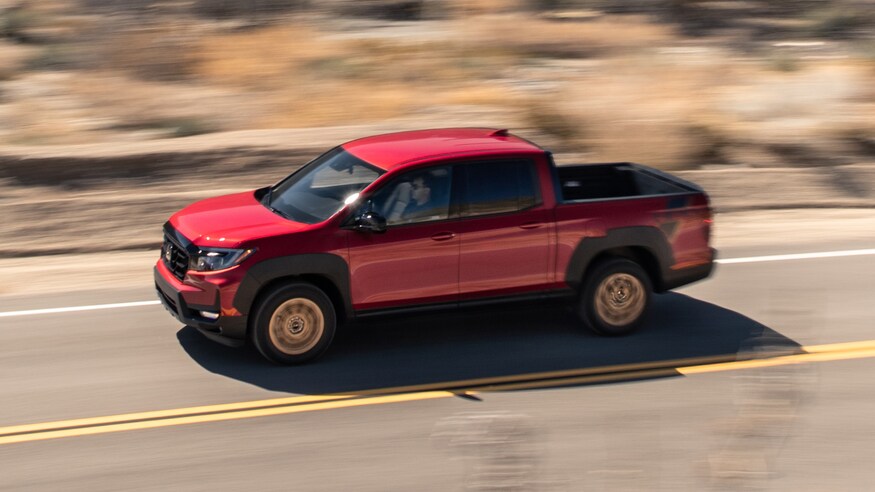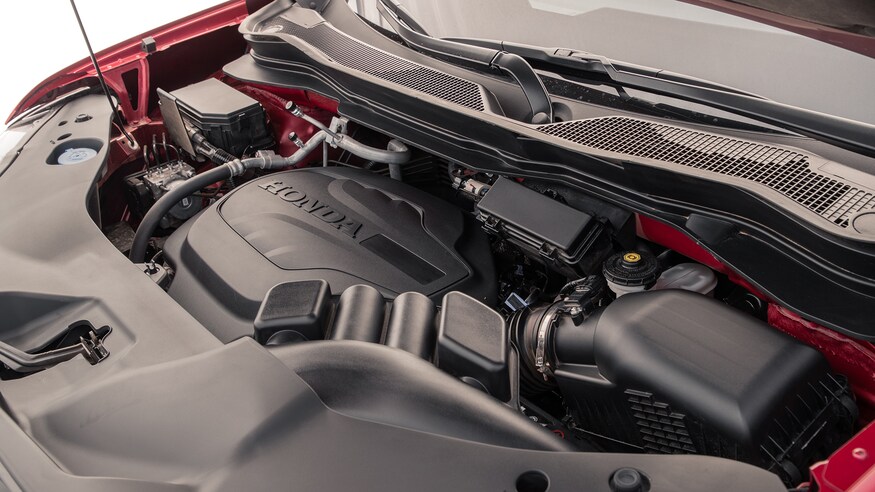2021 Honda Ridgeline Sport HPD First Test: Truckier By a Nose
Looking more like a truck makes all the difference for Honda's car-based rig.
"Can someone move the Pilot?" someone would call over the radio. "That's the Ridgeline," would come the eye-rolling response. Don't get us wrong, we like the Honda Ridgeline here at MotorTrend, but that exact conversation must've played out 50 times during our 2017 Truck of the Year competition. Everyone mistook the Ridgeline for our long-term Honda Pilot. If it had been the 2021 Honda Ridgeline, that never would've happened.
Let's just get it out of the way. The 2017 Honda Ridgeline midsize pickup looked like a Honda Pilot large SUV that had been Sawzall-converted into a truck (a surprisingly common trend among Los Angeles pool cleaners). That's not surprising, given the Pilot and Ridgeline have the same unibody platform underneath, also shared with the Odyssey minivan. (Honda engineers hate it when we say that, so we'll point out the bed structure is significantly different underneath than the rear end of a Pilot or Odyssey.) We dubbed the softer, rounder styling a retrograde move from the blocky, tough-looking first-generation Ridgeline, and it's been the truck's biggest drawback since.
Not now. Honda listened to the critics and toughened the 2021 Ridgeline right up. The grille and headlights have been squared up a bit and now stand upright, and a power dome bulge in the hood to clear it gives the Ridgeline a hint of that baby big-rig look all the full-size trucks have been doing since the '94 Dodge Ram. A pair of chrome exhaust tips poking out of a new rear bumper steals a visual trick from current Ram pickup to complete the look. It's a few small changes, but the overall effect is dramatic. This doesn't look like an SUV with a bed; this looks like a truck.
The updated Ridgeline still doesn't drive like a truck, though, and we're still not complaining. A fully independent suspension at all four corners allows for better individual wheel control and significantly less unsprung weight at the rear. As a result, the Ridgeline rides and drives like a modern SUV, not like a pickup truck. It's more planted and confident in a corner on pavement and has less body roll than traditional trucks. Bumps are far better absorbed and don't upset the chassis anywhere near as much. Despite the unique suspension design, the Ridgeline Sport still claims the highest payload capacity in its class (1,583 pounds) when equipped with all-wheel drive (Ridgeline) or four-wheel drive (everything else).
It's an important distinction. Honda's i-VTM4 torque-vectoring all-wheel-drive system is an impressive piece of engineering, able to send up to 70 percent of engine power to the rear wheels and then send 100 percent of that power to either rear wheel as needed. It's a slick system, but it has its pluses and minuses. In the good column, the computer can put power exactly where it's needed and change the way it responds depending on the conditions. This means putting the truck in Sand mode, for example, makes a serious difference off-road with more wheelspin to keep speeds up and torque-vectoring that pushes power to the outside wheel and rotates the truck in a turn. In the minus column, there's no low-range gear for serious crawling, and there are no true lockable differentials.
The components Honda engineers have chosen and their design priorities also limit towing capacity to 5,000 pounds; the best in the class pull 7,500.
Design choices also seriously limit things like approach, breakover, and departure angle, not to mention ground clearance. The Ridgeline is simply lower to the ground, which is better for aerodynamics and efficiency but worse for off-roading. In fact, sticking the exhaust tips out the bumper actually knocks 1.5 degrees off the departure angle, though flexible mounts allow them to tuck up into the bumper if they drag.
Point is, if you're buying a midsize truck to pull heavy trailers or do some rock crawling, the Ridgeline isn't for you. If you're doing literally anything else, though, it's a seriously compelling truck. The dual-opening tailgate (drop down or swing open), which makes loading and unloading heavy cargo a lot easier, is only sort of being copied by full-size trucks (not midsize). Same with the optional in-bed stereo system and ultra-strong composite bed. The lockable in-bed trunk is clutch for both bringing more stuff and keeping it secure and out of sight, and it can turn it into a pool or a cooler thanks to the drain plug. No one else is doing anything like that. Then there's the fact that the Ridgeline offers far and away the biggest and most comfortable cabin in the class.
That cabin's also seen a few updates since last we lined a Ridge. The Honda Sensing suite of active and passive safety features have been standard since this generation came out. A push-button shifter was introduced as standard last year, and for 2021, the infotainment system finally gets its volume knob back.
The shifter is now connected to a standard nine-speed automatic transmission and all-wheel drive, doing away with the old six-speed and the front-drive base model. With more aggressive gear ratios, the 2021 Ridgeline is significantly quicker, if you get it right. Our test team reported a very fine line between a strong launch and a total bog, but get it right, and you'll hit 60 mph in 6.3 seconds, about a second quicker than most other second-generation Ridgelines we've tested.
Otherwise, though, performance is the same as it's ever been: dead even with the rest of the class. Yes, you might have noticed the tires look a lot more off-roady than before, but it's not what it looks like. Honda worked with Firestone to add some chunky tread blocks to the shoulders of the Destination LE2 all-season tires to make them look cooler and added some wheel offset to push them out flush with the body. The blocks probably help a tiny bit in mud and sand, but that's it.
You get the tire dress-up regardless of which 2021 Ridgeline you buy, but not the wheels you see here. Our test truck was equipped with the $2,800 HPD appearance package, which also gets you the massive plastic fender flares, a different grille, blacked-out trim, and the HPD stickers and badge. You'd have trouble spending that much money on the same aftermarket parts, so unless you really dig the look, skip it.
At least it doesn't do anything to the fuel economy. If you're shopping Ridgelines, you might have noticed the highway rating has gone down slightly. Making the truck look tougher was bad for aerodynamics, but Honda designers worked hard to claw back every bit of drag coefficient lost. Those new intakes below the headlights, for example, are functional. Although the team didn't completely mitigate the losses, the Ridgeline still gets some of the best gasoline-powered fuel economy in the class.
Even without the wheel and sticker package, it's easy to be confused about the 2021 Ridgeline's pricing. At first glance, it appears to have gone up a ton. It didn't, however—not when you compare features. Yes, the base price is thousands more than in 2020, but that's because the cheaper front-drive model is gone. Compared to last year's all-wheel-drive model, the price has barely gone up, and it remains right on par with competitors in four-wheel-drive and four-door cab configuration. You can buy a cheaper midsize truck than the Ridgeline, but only by sacrificing space and some capability.
With the Ridgeline's biggest failings—its decidedly un-trucky looks and lack of a volume knob—resolved, there's really no reason not to recommend it. No, it isn't for the hardcore buyer, but those people are a minority of customers. For everyone else who just wants to do basic truck stuff, some hauling, and a little off-roading, the Ridgeline delivers as well as or better than the rest.
 Reviewed by Nemanja
on
March 06, 2021
Rating:
Reviewed by Nemanja
on
March 06, 2021
Rating:

















